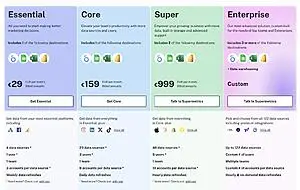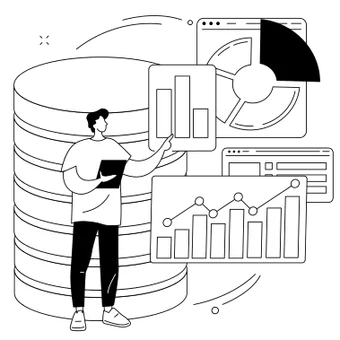Supermetrics vs PorterMetrics Comparison: What You Need to Know

Supermetrics and Portermetrics are great data integration tools. The connectors enable data extraction from organizational applications, including marketing apps, for data analytics. Supermetrics has about 138 connectors, while Portermetrics gives access to 19 data sources. The data destinations vary, but Looker Studio and Google Sheets are the most common. When choosing between the two platforms, the best approach is to consider the practicality of the platforms in meeting your data needs. This detailed review will help you understand the data connectors better.
Table of content
- PorterMetrics Overview
- Supermetrics Overview
- Who Are Supermetrics and PorterMetrics For?
- Supermetrics vs. PorterMetrics: Data Source Connectors
- Supermetrics vs.PorterMetrics: Data Destinations
- Supermetrics vs. PorterMetrics: Pricing
- Supermetrics vs.PorterMetrics: Rating
- Supermetrics vs. PorterMetrics: Security & Reliability
- PorterMetrics vs Supermetrics: Ease of Use
- Supermetrics vs. PorterMetrics: Support
- Summary
PorterMetrics Overview
Portermetrics has 19 data source connectors. Portermetrics also has two primary data destinations that include Looker Studio and Google Sheets. Any other destinations listed on Portermetrics are linked through Google Sheets. The pricing plans for Portermetrics start at $12.49. Lastly, Portermetrics lacks a data mapping feature, which means you may not be able to create new metrics and dimensions when using the platform for data integration. Depending on your data needs, the lack of a data mapping feature in Portermetrics could limit how you generate insights using the Portermetrics connectors. The screen below captures all the connectors on Portermetrics’ landing page once you are logged in with the paid plans.

The prominent differentiating feature we observe with Portermetrics is the setup for data sources. Basing the data connector numbers on the count of connected accounts, using Portermetrics involves adding and deleting accounts, especially if you have many accounts. The good thing about Portermetrics is that you have access to all nineteen connectors available on the platform.
Supermetrics Overview
Supermetrics is a robust data integration system with many connectors and data sources. Supermetrics has built more than 138 connectors. Its data destinations include analytics tools like Looker Studio and Power BI, spreadsheets like Microsoft Excel and Google Sheets, databases like BigQuery, and API integrations through Supermetrics API. For all the data sources and destinations, the integration begins from the Supermetric Hub, where you create the query for your data. The screen below shows the Supermetrics Hub with Power BI selected as the data destination. The screen shows the two steps that you need to integrate the data. Under the first step, where you create a data query, Supermetrics offers a data mapping feature that allows you to select data fields and compute new variables.

We tested Supermetrics for Looker Studio and Google Sheets. Supermetrics installs an add-on that opens as a sidebar when extracting data to Google Sheets. In the case of Looker Studio, the data integration involves the connector working as an extension. When the data is integrated, it automatically opens one of the report templates in Looker Studio, enabling you to explore the data if a report template is already available for your data source. If not, you can build your first report after setting up your data source and fields. The data integration service is fast and significantly automated. The data mapping feature reduces the time to insights. Supermetrics pricing starts from 29 euros.
Who Are Supermetrics and PorterMetrics For?
Supermetrics and Portermetrics are created for digital marketers. Businesses can use the data connectors internally to analyze their marketing data. Marketing agencies could also use the tools. Portermetrics’ pricing directly identifies plans for agencies. However, our testing and review of the platforms show that if you are an agency, Supermetrics is a better option than Portermetrics unless you have very few data sources regarding data source connectors and the number of accounts per data source.
We single out Supermetrics as a better agency connector because of its features. Specifically, the number of data accounts available on each plan implies that Portermetrics would be highly limiting for agency marketing applications. That is because marketing agencies would need to connect to many data accounts. For instance, an agency running marketing campaigns for five clients could have five different Facebook accounts from which it needs to collect data. The variety of data sources would also vary significantly between businesses. Therefore, marketing agencies need a data integration solution accommodating many data source connectors and accounts per connector. That is why Supermetrics wins over Portermetrics when targeting marketing agencies.
Supermetrics vs. PorterMetrics: Data Source Connectors
Supermetrics has significantly more data connectors than Portermetrics. With 138+ connectors on Supermetrics, the platform is barely comparable to Portermetrics, which has only 19. The number of connectors is essential because users must determine whether the two platforms have connectors for their specific data needs.
Portermetrics’s connectors are mainly for social media data sources, including Facebook, Instagram, X (Twitter), TikTok, and LinkedIn. The platform also has e-commerce connectors for WooCommerce, Shopify, and Amazon Seller. Connectors for Google My Business Profile and GA4 are also available. The last category of connectors covers CRM and email connectors, including Hubspot, Mailchimp, Klaviyo, and Active Campaign. Portermetrics is designed to send data from these specific sources to Looker Studio and Google Sheets.

Based on a review of the data source connectors available on the two platforms, the closing view is that Portermetrics lacks many of the standard data source connectors that your business requires. You should carefully check whether the connector is available before selecting the platforms.
Supermetrics vs. PorterMetrics: Data Destinations
Supermetrics has 16 data destinations. The five most popular destinations include Looker Studio, Google Sheets, Microsoft Excel, Power BI, and BigQuery. Supermetrics API is available for API calls, including Tableau data integrations.
Comparatively, Portermetrics has two primary data destinations: Looker Studio and Google Sheets. It also offers data integrations to a few other destinations, such as Power BI, but through Google Sheets. For instance, to export data to Power BI, Portermetrics begins by creating a web link to Google Sheets before using the link to access the data in Power BI.

It is essential to highlight that Portermetrics does not export data to any database. Therefore, if you need to extract data from a database such as BigQuery, Snowflake, Azure SQL, Amazon S3, MySQL, or PostgreSQL, Supermetrics would be your go-to data connector. If your data needs include API integrations, then Portermetrics would not be ideal, but Supermetrics would serve you well. Lastly, Tableau and Excel integrations are not available in Portermetrics but are available in Supermetrics. Tableau integrations in Supermetrics are through API.
On account of the data destinations, Supermetrics is a better data integrator than Portermetrics unless you are only interested in exporting data to Looker Studio and Google Sheets.
Supermetrics vs. PorterMetrics: Pricing
When you want to start using a new online service, the first step is almost always the trial version. Supermetrics and Portermetrics offer 14-day trial versions that do not require a credit card to sign up. While you would ordinarily get the best value with a paid plan, the case of the data connectors is different. The free trial lets you test all the data source connectors and destinations. That is meant to enable you to determine whether the connectors meet your data needs. When you begin using the paid plans, the number of data sources and destinations will be limited to specific connectors and destinations depending on your plan.

Paid plans start from €29/month in Supermetrics, equivalent to about $32. On Portermetrics, the starting price is $12.49/month. The price is significantly lower for Portemetrics, but what does it offer?
For Supermetrics, the price gets you 4 data sources, one destination, one user, and three accounts per data source. Comparatively, the base price for Portermetrics gets one account and one destination in the Solo plan. The comparable Portermetrics price is $33.33/month for the Teams plan. The Teams plan includes 5 data accounts from any of the data sources.

Note the reference to “data accounts” in Portermetrics’ pricing plans. Portermetrics provides an example of what 5 data accounts to be: “3 Facebook accounts on Looker Studio and 2 Instagram accounts on Sheet.” Similarly, if Portermetrics offers you 40 accounts in the Agencies Pro plan, priced at $150/month, it means 40 accounts from any data source. The plans by Portermetrics provide access to fewer accounts than Supermetrics at all levels.
Another important pricing question is whether all connectors are available on all pricing levels. Portermetrics gives you access to all connectors on all pricing levels, subject to the number of accounts you can connect to in your plan. Supermetrics does not grant you access to all connectors. Instead, you select the connectors you intend to use in the Supermetrics Hub. Once the connectors are included in the pricing plan, those are the only data source connectors you can access. Supermetrics limits the number of data source connectors you can access under each plan. The Essential plan allows 4 data source connectors. The Core plan permits 26 data source connectors, while the Super plan allows 54. The enterprise plan provides up to 125 data sources. Since Portermetrics uses the number of accounts in pricing, the highest-priced plan on Portermetrics, the Agencies Pro plan, allows access to fewer accounts than the Supermetrics Core plan.
Another point on pricing focuses on the number of users allowed on the two platforms. Portermetrics grants unlimited users access to every plan. Comparatively, Supermetrics limits the number of users to 1 for the Essential plan, 3 for the Core plan, and 5 for the Super plan. You can also customize the number of users in the Enterprise plan, but there are no plans for unlimited users.
Lastly, the pricing plans do not allow the use of all destinations. On Supermetrics, the first step is selecting the destination, and the client can only access the destinations attached to the subscription. The Essential plan allows only one destination among four, which includes Looker Studio, Excel, Sheets, and Power BI. The Super plan, however, provides access to two of the four data destinations. In Portermetrics, the pricing plan includes access to Sheets and Looker Studio.
Supermetrics vs. PorterMetrics: Rating
Both platforms are rated 4.4 out of 5 stars. We qualify the ratings further by noting that the 4.4 rating for Supermetrics is based on 732 reviews on G2. Comparatively, the 4.4 rating is based on a significantly smaller number of reviews at 102. Having tested the two data integrators, we would rate Supermetrics slightly higher or qualify the ratings more because they have huge differences.

We would assign Portermetrics a lower rating because the data integrator is not very friendly when working with data destinations other than Looker Studio and Google Sheets. Basing the pricing plans on the number of connected accounts instead of data source connectors is highly limiting, so an agency would not find value using Portermetrics. Even small organizations running digital marketing campaigns on multiple online channels would find difficulties using Portermetrics agency plans because of the limited number of accounts allowed in each plan.

Supermetrics is more robust based on the number of data sources, accounts, and data destinations, including API and database integrations. For that reason, It would have wider applications in businesses of all sizes. The variety of no-code connectors makes It easy to use for a large number of organizations.
Supermetrics vs. PorterMetrics: Security & Reliability
When evaluating the data integrators, we consider two important security metrics: SOC Type 2 Compliance and Single Sign-on/MFA features. Supermetrics has both properties, thereby qualifying the security and reliability test.
On the other hand, Portermetrics lacks both requirements. Therefore, this detailed review votes for Supermetrics on account of security.
Portermetrics is relatively new, and its security features are just catching up with other players in the industry. The connectors’ function, for the most part, is the same as that of Supermetrics. Organizations that handle sensitive data and require demonstrable compliance with data security standards would find Supermetrics better than Portermetrics.
PorterMetrics vs Supermetrics: Ease of Use
Supermetrics and Portermetrics are characterized by ease of use. The process of downloading and installing the data connectors is interactive. Integrating data with both platforms follows simple steps, including selecting the data destinations and sources and specifying the data fields for the data tables.
For Supermetrics, the data sources must be chosen in the SupermetricsHub. At the same time, Portermetrics gives access to all data connectors with easy deletion and addition of data source accounts in your plan. Being a no-code connector means that Supermetrics and Portermetrics do not require technical skills.
Portermetrics is easy to use if you integrate data into Looker Studio and Google Sheets. The platform is also suitable for integrating your data sources with data presentations, including Google Slides and Canva. Portermetrics also integrates with Zapier, Gmail, Slack, and ChatGPT to provide updates and notifications about KPIs. Integrating into these applications is completed through Google Sheets. These features contribute to the ease of using Portermetrics to report your data’s key performance metrics.
Supermetrics vs. PorterMetrics: Support
Support on Portermetrics is tied to your pricing plan. For the Solo Plan, you get live chat and email support. For the rest of the pricing plans, you get 1-1 video calls, live chat, and email support only if you have an annual plan. Portermetrics also has an FAQ section to guide you on significant issues.
Focusing on Supermetrics, the Essential and Core plans include standard support, including chat, email, and FAQ. If you are on the Super plan, you will get access to a customer success manager in addition to standard support. The highest plan, the Enterprise plan, includes a personal success person in addition to the support level available to the lower pricing plans.
Overall, our assessment of the support structures on the two platforms indicates adequacy in meeting the support needs of many users. The additional support available on Supermetics can be precious if your organization is large and has diverse data needs that may include API integrations and if the needs include some level of customization. In the case of Portermetrics, live video calls would be most useful when dealing with the number of accounts you can set up and connect to.
Summary
Our testing shows that both Supermetrics and Portermetrics deliver on their promises precisely. That said, when choosing either platform, users must consider aligning their data needs with the features offered.
Mind the data counts you intend to connect when assessing Portermetrics pricing plans to surmise what that decision would be like. For Supermetrics, count the data sources because the platform prices the data integration services based on the number of data sources.
Lastly, consider the data destinations. Portermetrics will connect you to Google Sheets and Looker Studio. For any other data destination, go directly to Supermetrics. You should consider other factors, such as price, only after finding the data sources and destinations. The rest of the features are as expected because Portermetrics is relatively new, while Supermetrics is a more established data integration platform.
If your choices are not limited to Supermetrics and Portermetrics, you would benefit from looking into the no-code Windsor.ai connector. Begin by considering our 30-day free trial for all connectors and data destinations.

Try Windsor.ai today
Access all your data from your favorite sources in one place.
Get started for free with a 30 - day trial.
Read also:
Read also:
Supermetrics vs Coupler.io Comparison: Detailed Guide
Supermetrics vs. Segment a quick comparison
The Best Alternatives to Improvado
The Best Alternatives to Fivetran
Coupler.io Review – The Good and Bad for 2024
Porter Metrics: Overview, Pricing, Key Features and Alternatives
Top Adverity Alternatives and Competitors
Dataslayer.ai: Overview, Pricing, Key Features and Alternatives


